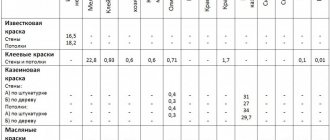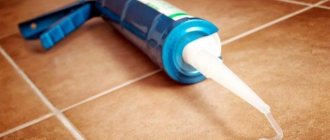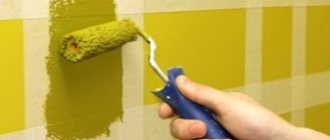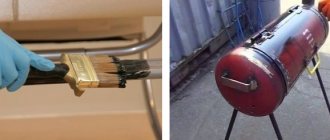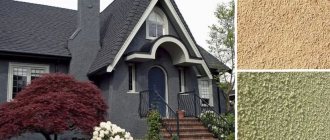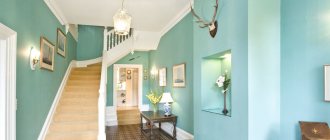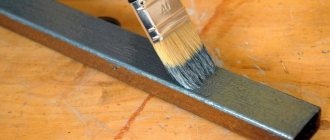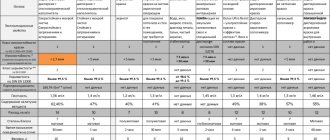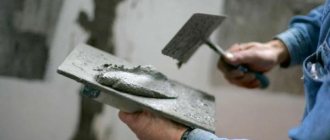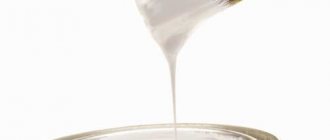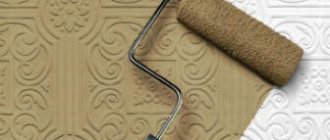Calculate the area
In order to calculate the amount of paint, you need to calculate the surface area. To do this, you need to multiply the length (6) by the width (4) of the surface to be painted (24). Such actions must be carried out on all surfaces.
- If you will cover different surfaces with different colors, it is better to calculate the area separately. You can add up the surface area covered by one color.
- The surfaces covered with white are calculated together. The surface area covered with beige must be folded.
If it is necessary to cover a surface covered with wallpaper, the principle of measuring the area does not change, but the paint consumption will differ.
Types of surfaces
Before calculating the paint consumption for painting ceilings, you need to decide on what basis the painting will be done. In apartments this is most often a concrete floor, leveled with gypsum plaster (see Ceiling plaster: leveling and decorative finishing).
- But the ceiling can be pre-sheathed with plasterboard or boards, covered with wallpaper or tiled for painting. In many private houses, there are not concrete, but beam floors, which are hemmed not only with plasterboard, but also with chipboard, plywood or OSB boards. These surfaces, like concrete ones, are first puttied and sanded, and then painted.
Painting a ceiling lined with chipboard
- By the way, the texture of concrete is in fashion today. This is the so-called “art concrete”, used as an option for interior design. It involves painting the ceilings without plastering - only textured paint is used (see Textured paint for the ceiling: a modern look), with the appropriate effect. Similar finishing is used to decorate rooms in the following styles: hi-tech, techno, loft. You can see one of these design options in the photo below.
Art-concrete ceiling
Each of the listed bases requires certain preparation before painting. The quality of the painted surface as a whole depends on how accurately the technology and procedure for performing operations are followed. The fact that painting requires a flat and smooth base, we think, is clear without words.
Preparing for painting work
Paint is expensive these days, especially decorative options. It is quite natural that when carrying out repairs, everyone wants to keep its consumption to a minimum. But this should not be at the expense of quality.
Impregnation with a primer composition is a mandatory operation when painting all types of bases - only in each case a different type of primer is used (see Primer for the ceiling - a useful necessity).
So:
- Typically, the manufacturer’s instructions clearly regulate in what cases one or another composition can be used. By the way, for this it is not at all necessary to purchase a factory-made primer. The role of primer can be played by the same paint that is supposed to be used for finishing, only diluted with your own hands to a liquid consistency.
One of the options for universal primers
- Interior paints can only be diluted with the liquid on which the paint is made. In the case of water-based emulsion, water can be used. Alkyd enamels require a special solvent, but due to the high price of these paints, it makes no sense to use them for priming. There are primers on sale that are determined by - they are suitable for all types of substrates.
- When the soil dries, a thin film forms on the treated surface. At the same time, it stops absorbing moisture from the paint, dust is neutralized, and the adhesion of layers is enhanced. It is only important that before treatment the base is well cleaned of oil stains, rust, mold, soot, and, of course, old paint.
The consumption of universal primer varies between 130-150 g/m2, which means that a ten-liter flask will be enough for you to treat at least 130 m2 of the area to be painted. This packaging costs between 680-1250 rubles, and this is a fairly reasonable price for anyone.
Calculation of paint per 1m2
In order to calculate paint consumption, we first study the data provided about the paint by the manufacturer. It indicates the hiding power of the paints and the dry residue. Hiding power is the ability of paint to cover the original color of the surface in one layer.
Dry residue is the composition that remains on the surface of the paint after drying. A simple formula will help you calculate paint consumption per 1 m2.
Having data on covering power and dry residue, you can calculate the most approximate amount of consumables. it can be calculated using the formula:
- (Spreading power/dry residue)*100
- In order to calculate the amount of material required for an area of 24 m2.
- Covering power (140) divided by dry residue (70) multiplied by 100 and get paint consumption per 1 m2
- (140/70)*100=200 g per 1m2
- 200*24=4800g (per 24m2)
To calculate consumables for the resulting area, multiply the consumable data for 1m2 by the area.
Paint consumption may vary depending on the surface to be coated. Paint consumption for concrete or brick surfaces will be 10-15% higher compared to coating wood and metal. You can pre-coat the surface with a primer, this will significantly reduce paint consumption.
Oil paint consumption per 1 m2
On average, to cover a surface in one layer you need 110-130g of paint per 1m2.
The average value can change significantly for different types of surfaces, iron, wood. The material consumption is also affected by the brush, the method of painting and weather conditions.
Water-based paint consumption 1m2
One meter square may require 140-160g of paint per layer. To obtain a dense and rich layer of paint, it is necessary to cover the surface in 2 layers.
When purchasing water-based paint, you should not save money. The consumption of cheap paints is much higher. To obtain an even and bright layer, you will need to cover the surface in several layers. It's better to spend a little more, but at the same time reduce paint consumption.
Acrylic paint consumption per 1m2
The average consumption of acrylic paint for indoor work is 130-200g per 1m2. When working outdoors, paint consumption increases. To paint concrete or brick surfaces, you will need 2 times the average amount of paint.
Oil paint consumption per 1m2
A universal and most common type of paint used to cover walls, ceilings, windows, and doors. Oil paint consumption can be calculated using the formula given above. Consumption may vary depending on pigmentation and desired result.
Weather
The staining conditions are usually prescribed by the manufacturer. Recommendations for humidity and temperature conditions should be strictly followed. Some formulations are designed for use at low temperatures. The following parameters are considered optimal for painting metal:
- humidity – 75-80%
- temperature – +5-+20°С.
In this case, you should avoid direct sunlight and wind, which will negatively affect the result. High humidity or wind can increase costs several times. Painting indoors, subject to regulatory standards, will bring the level of material consumed closer to the indicator specified by the manufacturer.
It should be borne in mind that in any case there is loss of coloring agent when:
- painting indoors – 5%;
- normal humidity, outside temperature – 5%;
- high humidity, strong wind – 20%.
The best time for exterior painting is morning or evening, when there is no direct sunlight.
Paint consumption
Paint consumption rates vary from 130 to 200 g, taking into account covering the surface in one layer. The density and consumption of paint varies depending on the color.
Let's consider the consumption of paints and varnishes depending on color:
- White paint material covers from 7 to 10 m2;
- Red paint material covers up to 20 m2;
- Green paint material covers from 11 to 14 m2;
- Brown paint material covers from 13 to 16 m2;
- Blue paint material covers from 12 to 17 m2.
- Red and yellow paints and varnishes cover from 5 to 10 m2.
Consumption data is based on the consumption of one liter of paint. The paint must be diluted with solvents such as white alcohol or solvent. You can dilute the paint with other solvents you have, the main thing is to maintain the proportions. The paint must be diluted one to one.
It is necessary to apply the paint in several layers, between applying layers you need to wait until the previous layer has completely dried. It should take at least a day for it to dry completely.
The paint consumption table will provide you with consumption data in more detail.
| Type of paint | Paint consumption liter/1m2 |
| Acrylic paint | 0.250l – 250g |
| Latex paint | 0.600l – 600g |
| Oil paint | 0.120l – 120g |
| Polyvinyl acetate (PVA) paint | 0.550l – 550g |
| Silicone paint | 0.300l – 300g |
| Silicate paint | 0.400l – 400g |
| Enamel paint | 0.150l – 150g |
| Enamel PF-115 white paint | 0.120l – 120g |
| Enamel PF-115 yellow paint | 0.140l – 140g |
| Enamel PF-115 green paint | 0.080l – 80g |
| Enamel PF-115 blue paint | 0.072l – 72g |
| Enamel PF-115 brown paint | 0.070l – 70g |
| Enamel PF-115 black paint | 0.055l – 55g |
| Tikkurila water-based paint | 0.110l – 110g |
| Tikkryla alkyd paint | 0.110l – 100g |
| Tikkurila adhesive paint | 0.250l – 250g |
Features of paint PF-115
PF-115 paint belongs to Pentaphtal enamel. Those. to a material that contains alkyd resins and semi-dried oils, which promote rapid drying of the enamel. This type of material is very popular for finishing both interior and exterior spaces. And for any surfaces.
The paint mixes easily with other substances, from analog enamels to primers. Another feature of enamel is its resistance to environmental changes.
The material fits very well on the surface for painting, and almost anything can be used as a tool: rollers, brushes and spray guns.
The latter option is especially good for spraying enamel. The paint dries in about a day.
Enamel is used for painting:
- Internal surfaces of premises;
- Outdoor premises;
- For metal, plastic and wood.
Painting tool
Of course, the coloring tool you choose also affects your paint consumption.
- A machine that sprays paint is considered less depraved; its advantage does not end there, it not only saves the material used, but also applies the paint in an even layer without drips.
- After the spraying apparatus, it firmly established itself in a leading position in paint saving.
- The most consumed tool is the brush; it increases consumption by 10%.
If it is used to cover concrete or brick surfaces without prior priming, the material consumption will increase by up to 20%.
How to calculate the amount of paint for painting wallpaper?
The approximate consumption of water-dispersion paint is 1 liter per 7-7.5 square meters of wallpaper surface (0.12 - 0.14 liters per 1 m2). The number of layers applied directly depends on the quality of the paint itself. When using expensive paint, two layers will be enough; if the paint is cheap, you will have to apply three layers.
Interesting materials:
What caused the Red Book of Russia to appear? What is the state emblem? What do you know about the history of the Russian coat of arms? What is Inn in Russia? What is the Russian Federation for children? What is the Russian Constitution? What is the Russian sector of the Arctic? What is Judgment Night in Russia 2022? What is the territory of the Russian Federation? What is it like in Russia? What is Call for free to MTS Russia 100?
Photos of the best types of paint
Main factors when choosing paint
Having decided on the color and familiarized yourself with the wide range of paint and varnish products, you must determine for yourself the main factors that will influence your decision, namely:
- hiding power of paint, because this determines the consumption of material;
- jar volume;
- price;
- masking properties (matte paint hides surface unevenness much better than glossy paint).
Effect of color on consumption
The lighter the future background should be, the more paint will have to be used. If one kilogram of black paint is enough to paint 7-10 square meters, then the yellow counterpart will have to be used in the amount of 12-14 kg.
The increase in consumption also contributes to:
- Dark or light base, which must be hidden with an opposite color coating;
- The need to mix two to four colors to obtain a complex color scheme.
However, mixing different formulations is not recommended. At best, such an experiment will reduce the durability of the coating; at worst, it will cause a chemical reaction.
Focus on inventory
Finally, before painting, you need to ensure the versatility and high quality of the equipment. If paint is applied exclusively with one roller, then the corners may remain untreated.
A worn roller or brush does not absorb liquid well, which later results in drips. A shallow tray limits your actions and forces you to pour paint every time, which increases the risk of splashing.
Comparison of materials from Dulux, Tikkuril and other popular manufacturers
Painting the walls
Each manufacturer improves the technical characteristics of the material with its specific additives. As a result, the hiding power of similar compositions varies from company to company. The table shows white matte paint for the ceiling.
| Firm | The basis | Coverage rates 1 liter, per m2 |
| Dulux | latex | 9 — 13 |
| Dulux | water-soluble | 7 |
| Marshal VD | water-dispersed | 7 — 9 |
| Tikkurila Fincolor | water-dispersed | 7 — 9 |
| Tex | water-soluble | 4 — 6 |
| Tex | based on latex and acrylic | 9 — 12 |
| Beckers | latex | 8 — 12 |
| Beckers | water-based | 7 — 10 |
When buying paint, add to the estimated quantity the cost of losses of 5 - 7%, depending on experience and the location of the surface. The smallest for the floor, since there is nowhere for liquid to drip and drain. For walls, consider the tool:
- spray gun – 3%;
- roller with medium pile 4 - 5%;
- brush up to 7%.
The largest amount of the composition is absorbed when applying the first layer. High-quality soil and materials from one manufacturer save their costs and drying time.
Adblock detector
